Miyajima Shrine - One of the Japan's three most scenic places
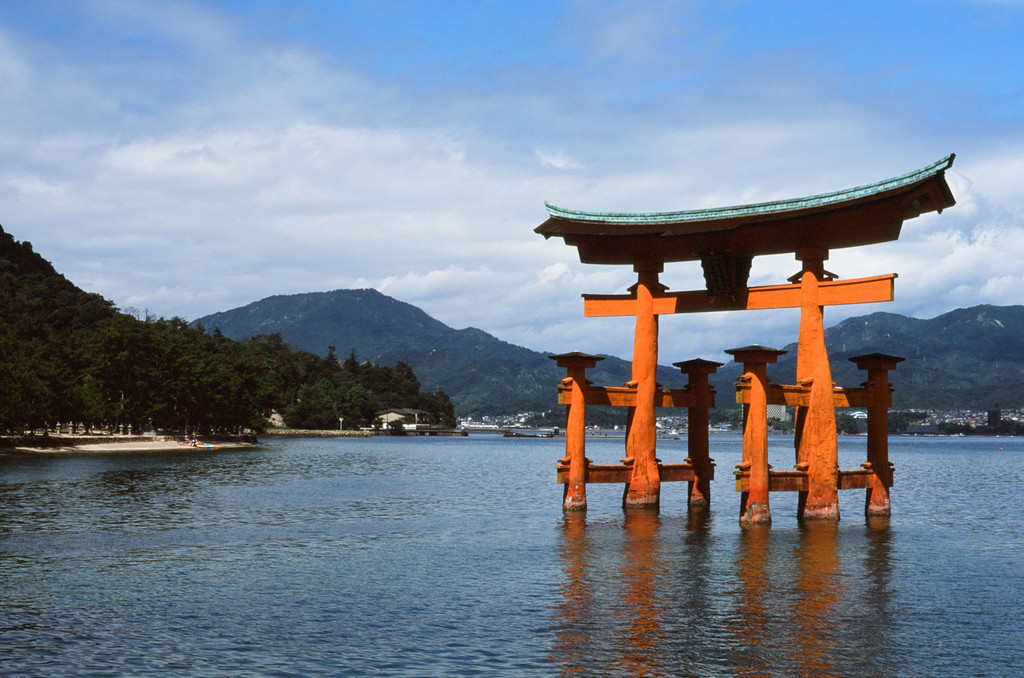
Okay! Here comes another amazing site from Japan! Actually the word is about one of Japan's Three most scenic sites (Nihon Sankei) which date back to 17th century. I would like to represent you my story and experience of visiting the famous Miyajima Shrine near the city of Hiroshima.
This happened on Day 20 of my stay in Japan and the 4th of the camp. The day before we went on a 6 hours long bus trip from Osaka to Hiroshima where we had visited the Peace Memorial Park and the Museum. Afterwards went to the hotel where we got our own rooms, had a discussion in groups about peace organised by our LC and then enjoyed several country presentations. I spent the rest of the evening before sleep thinking about life and Hiroshima and posting news, photographs and impression on Facebook. We tried to get out on the street for half an hour for a walk but (as I suspected) we were not allowed and I can understand that.
Leaving the hotel and by bus to the ferry
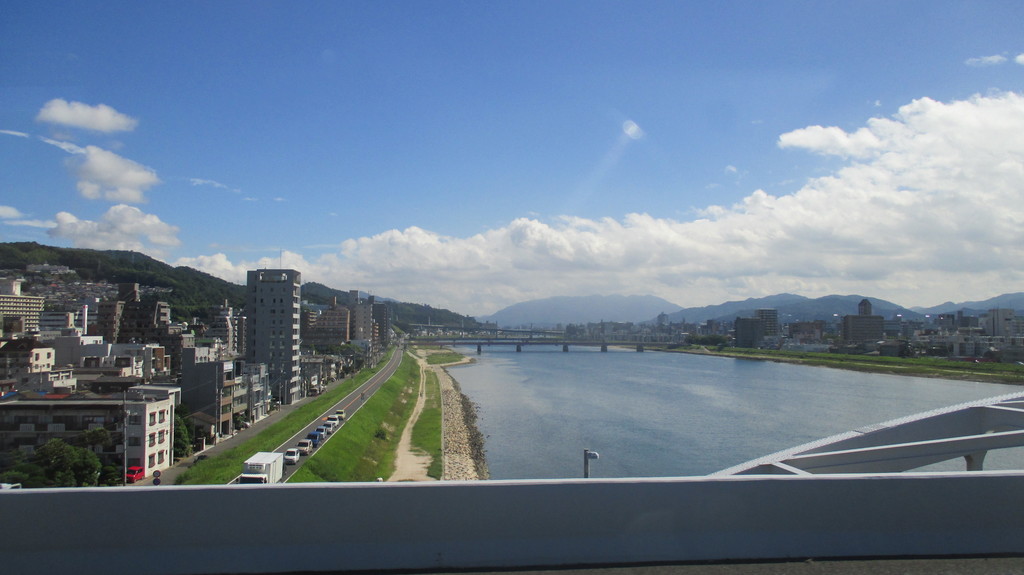
I had already packed my stuff for the next morning before going to sleep so when waking up at 7 a. m. I did not have any problems with rushing or forgetting something. The breakfast was organised at 7. 30 downstairs. I was on the 4th floor I believe and went downstairs by using the elevator. As we had to pass by the hotel's reception desk I was fully in the mood (already awake) and greeted happily the staff with "Oyasumii! " which actually means "(Good) Night! " and when I realised what I said I clapped my forehead and they were laughing.
Also, there was an anecdote the night before when we had no idea what do before sleeping... so several of us went in socks around the hotel and down to the entrance. I still do not know how that happened by my friend and I were together in socks in the elevator with some other guests... and it was funny.
I was among the first to be down there for the breakfast and enjoy using the buffet along with several other Japanese guests. After being done with the meal we all met in front of the entrance doors around 8. 20 and by 8. 30 were in the bus off to Miyajima!
The bus ride to the ferry terminal on the opposite side of the island was less than an hour of a ride. I tried to take some more photos outside the bus window as we were leaving Hiroshima (until next time! ) so here is one from the bridge over the river delta.
We were going to the southwest of Hiroshima and I do not remember much of the landscape except for going most of the time pretty close to the sea. At one point I saw a building on the other side (maybe was still Hiroshima in the distance or some bay closer) which looked like the Capsule Corporation from the Dragon Ball.
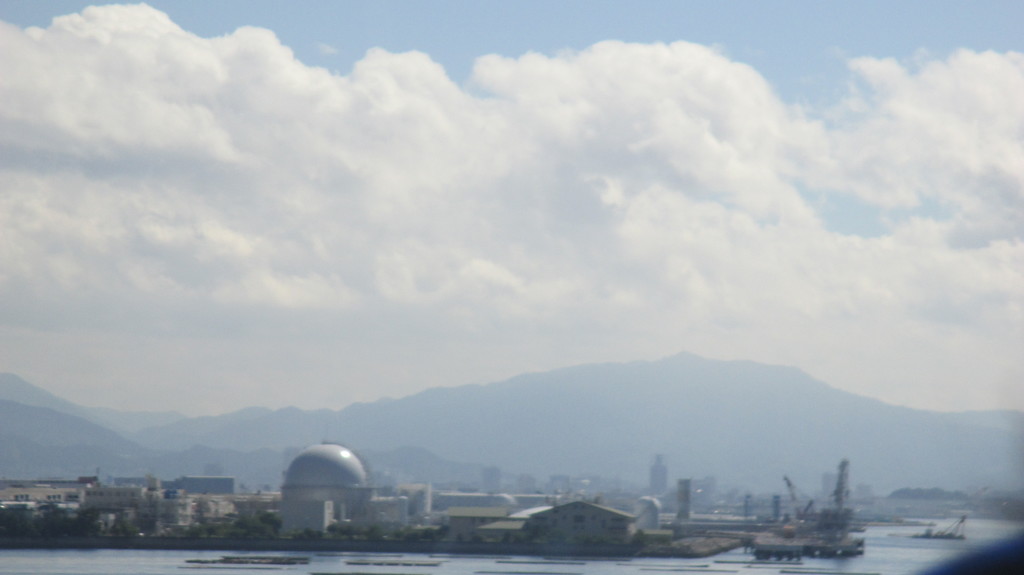
Ferry ride
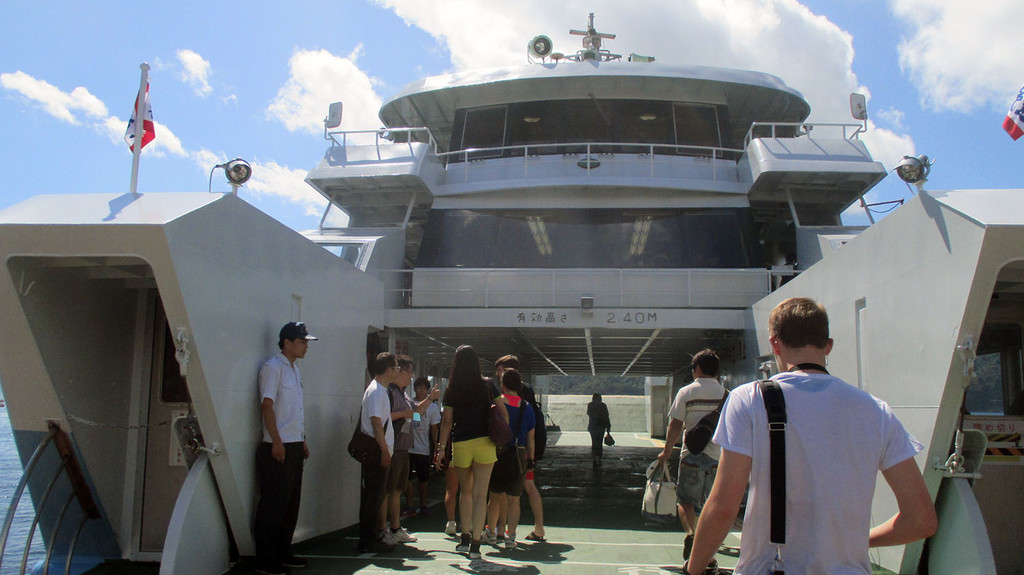
Alright, we arrived to the ferry terminal called Miyajimagushi. There are apparently several daily ferry rides between the island and the land (the big island Honshu). The ferry was pretty comfortable and the ride took about 10 minutes. The route was cca 2 kilometres long.
We all gathered on the first platform which had lots of chairs in several rows in the middle facing you with two views. The one to our left was towards Hiroshima far in the distance and to our right the bay and the mountains on the island.
Arrival on the island and about the island

There we are. We arrived to another ferry terminal, pretty big one and looked from the inside more like a small airport. Once out of the building we saw some kind of a square and lots of nice houses with shops. One more thing that totally caught our eyes were the deer that were walking around freely. I also put you our route around the place. And now a few words about the island and the shrines.
One of Three most scenic sites of Japan
Along with Matsushima and Amanohashidate Miyajima has been referred to as one of the Three most scenic spots in Japan for the last couple of centuries. I checked the other two but so far I am happy we went to Miyajima instead visiting the other two.
Firstly, the name of the island is Itsukushima but is rather known by its popular name as Miyajima which actually in Japanese means "Shrine island". I guess here must be some game with the regional Japanese as in the standard one an island is "shima" (remember Hiroshima, the wide island). The whole island is mostly known by its famous 'torii' gate. I will write more of it once we reach it. Torii is indeed the number one symbol of Miyajima and as you can se on the photograph it is "totally Japanese" what we would say. If you care (I doubt) the whole area formally belong to the administrative area of Hatsukaichi city on the Honshu island.
The island of Gods
The island is the home to the Shinto shrine of the same name - Itskukushima (Miyajima) shrine which is on the list of UNESCO's World Heritage. I was curious to know more about Shinto and it refers to the places (shrines) dedicated to the gods. Or better - these are the places where those gods dwell and the visitors come to pray to them, worship them or pray for good fortune. I always remember here the cat with one paw in the air, the so called "manakenineko" which can be found at many shrines... and within the restaurants, stores or even in homes... and represents the travellers and again good fortune and luck. Some of you might have known already that Shintoism is actually the "domestic" religion of Japan and there are about 80 000 Shinto shrines around Japan.
The whole island is full of beautiful shrines and I really do not remember how many of them we had seen but I will note the two later in the text and write a bit more.
The island is situated at the Seto Inland sea. I heard stories and later saw it with my own eyes on google images that the place is especially beautiful in the evening, kind of a romantic place too, and in other seasons with even snow!
The deer around the island
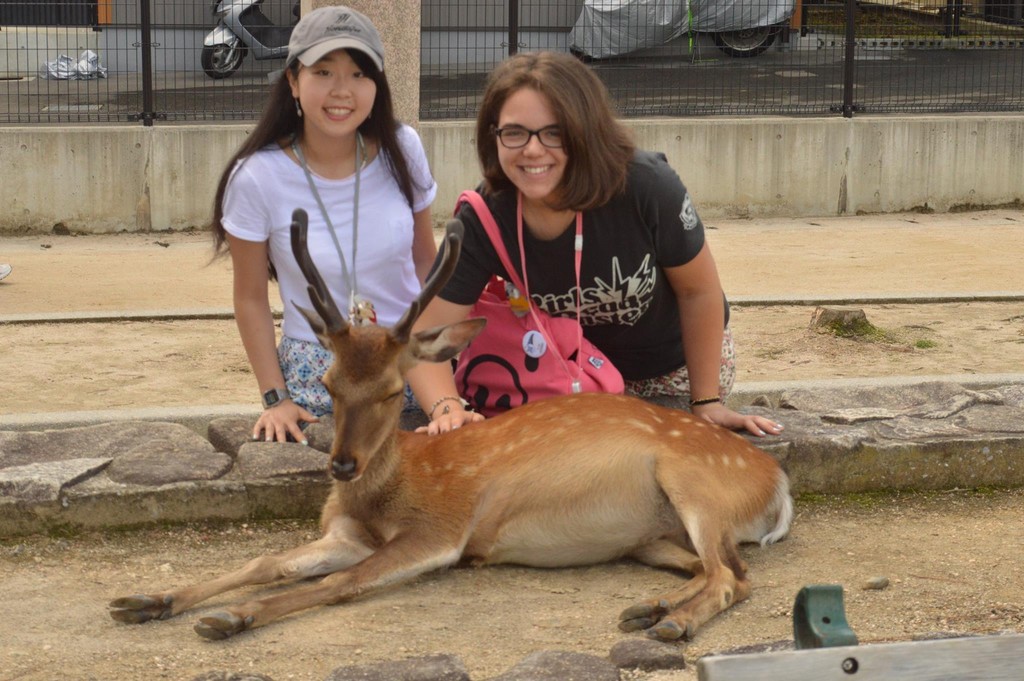
Okay, jumping from the World Cultural Heritage to the deer. They have a freedom of roaming around the areas and shrines so do not be surprised if one just pops up next to you from nowhere! We were told they have been used to the visitors and really no one had any problems with them. They were just another awesome thing we experienced there.
You should watch out for the poop on the road though.
Walking along the promenade
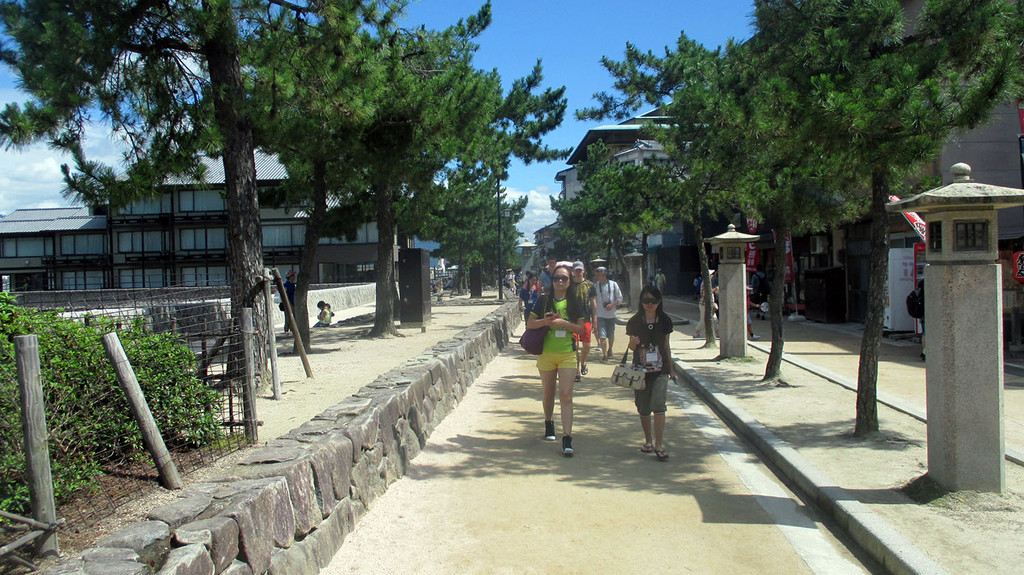
When passing to the promenade and started walking towards the torii (which we still could not see) we passed by the World Cultural Monument and started walking along the sea.
To our left were again many houses and shops that attracted us but the camp staff asked us to be a little bit more patient and wait for the free time later (and I was especially keen on going shopping! ).
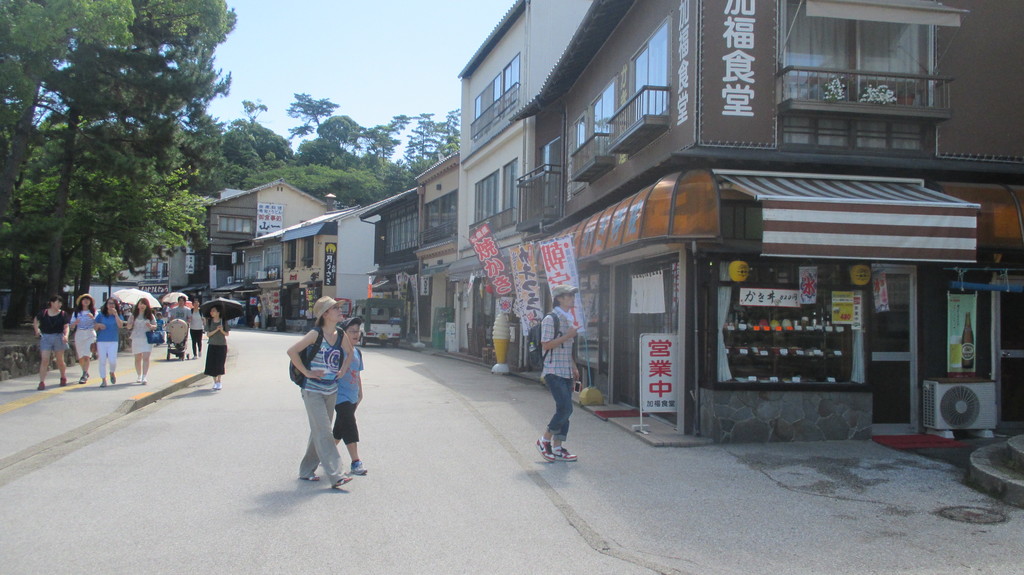
As you can see above there were two paths with a row of threes and every 8-9 meters a column. What cannot be seen here to the left is the sand beach or at least sandy entrance into the Seto sea. One could see many boats with the fishermen (or some other service? taxi boat? ) with the typical Asian cone-like straw hats. Just as I wanted to make one photo of them with analog camera they escaped me and the sky turned dark for a moment. Apparently was not meant to be.
To the right on the photograph are these mentioned houses including the Police Station. Behind this row of buildings one can enter into Omotesando Street which is also known as the Shopping Street there. Later on at this place where one street connects Omotesando with the promenade we came across the Samurais and I also had the opportunity to realise one wish that had to be done in Japan thanks to my friends... more of it soon.
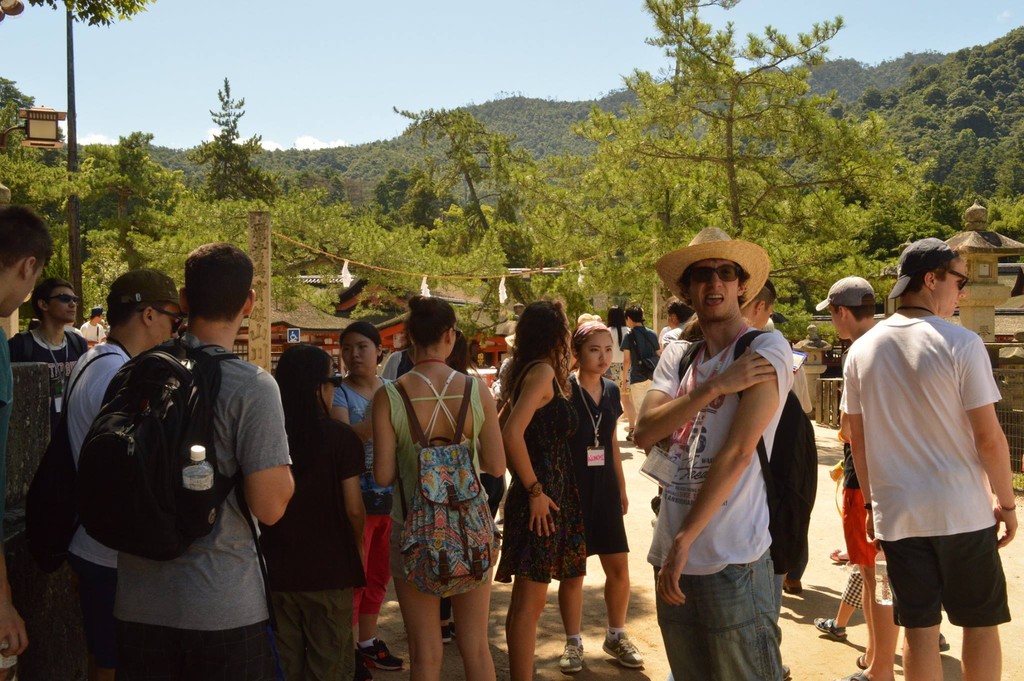
After passing by the World Cultural Monument and entering this part with two walkaways and the sandy beach next to us we had for the first time a view towards the grand Torii. Here is one photo of it.

We now approached the big gates, maybe another torii (not the one we are looking forward too) and then went through the shadows. The road was not only sand and indeed many deer went there. Not to forget the poop all around!
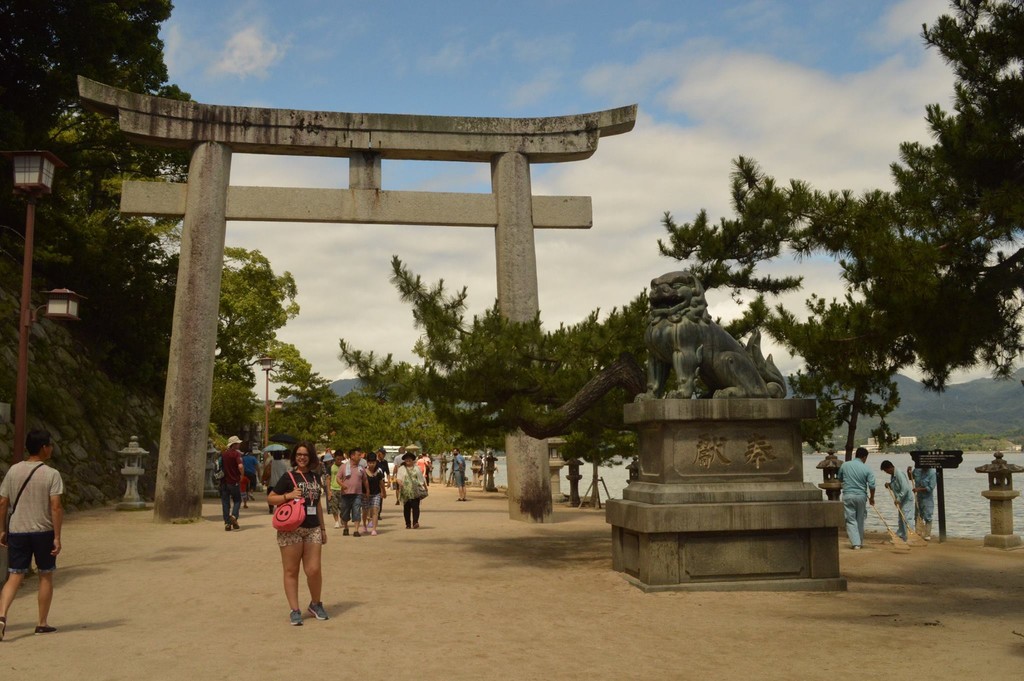
As you can see, the torii here is grey or rather simple not coloured. Toriis are usually orange with some black painted parts. In front of this one there was a statue of a hmm lion (makes no sense) or dragon? I am not sure what I see on the photograph. The other thing you can notice are the tall lamps and the pine trees.
After a minute or two (and petting the deer) we came to the edge or a dock where one had a nice view towards the big Torii.
The big Torii

It looks totally... Japan! I find this monument or gates to be pretty amusing. And it also looked big but standing there I could not determine how big it was. The sea in front of us here was pretty shallow though and as I found out on the internet later one can reach the big Torii once the tide is replaced with the ebb. I wish I could experience there! Half of the area you see up there (around the Torii) can be reached by walking around. And I found the information that the Torii here is about 16 meters high. Look at this photo with people beneath!
Torii is one of the most recognisable symbols of Japan and the main one of the shrine here. We were told that the original gates were put here somewhere around 11-12th century but were replaced with the newer one at the end of the 19th century. Because this bay here is pretty shallow the Miyajima shrine is actually built on the sea.
Another story our guides told us is that people, when there is no tide, also go to collect the shells around the gates. Also, during the strongest tide the gates look as if they were floating on the surface of the water. I have not noticed that there.. or we just came several hours before the highest point of the tide. I wish I can visit this place one more time and have much more time to explore the island. That is the universal problem with everything that has no simple clue - once you have seen something it is difficult to pretend it does not exist anymore.
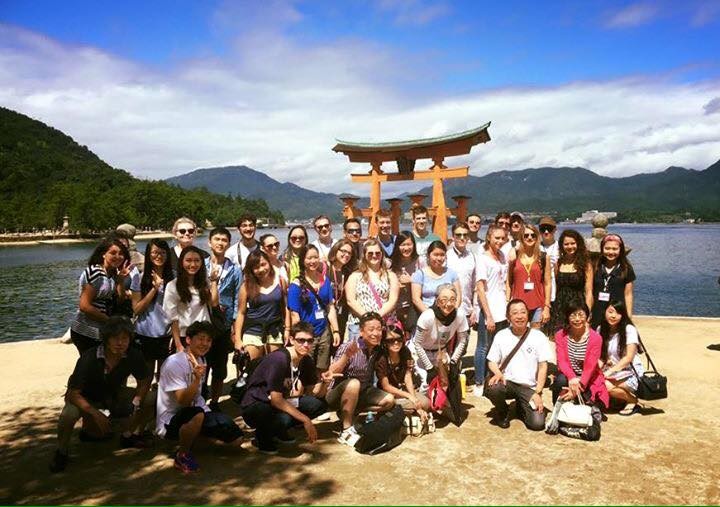
We took a group photo in front of it and then headed towards the shrine which was not far away. On our way there there were more sculptures dedicated to some kami (god or gods) maybe? I have to do more research, while writing this I just got hyped up as I am going through the whole experience again in my head.
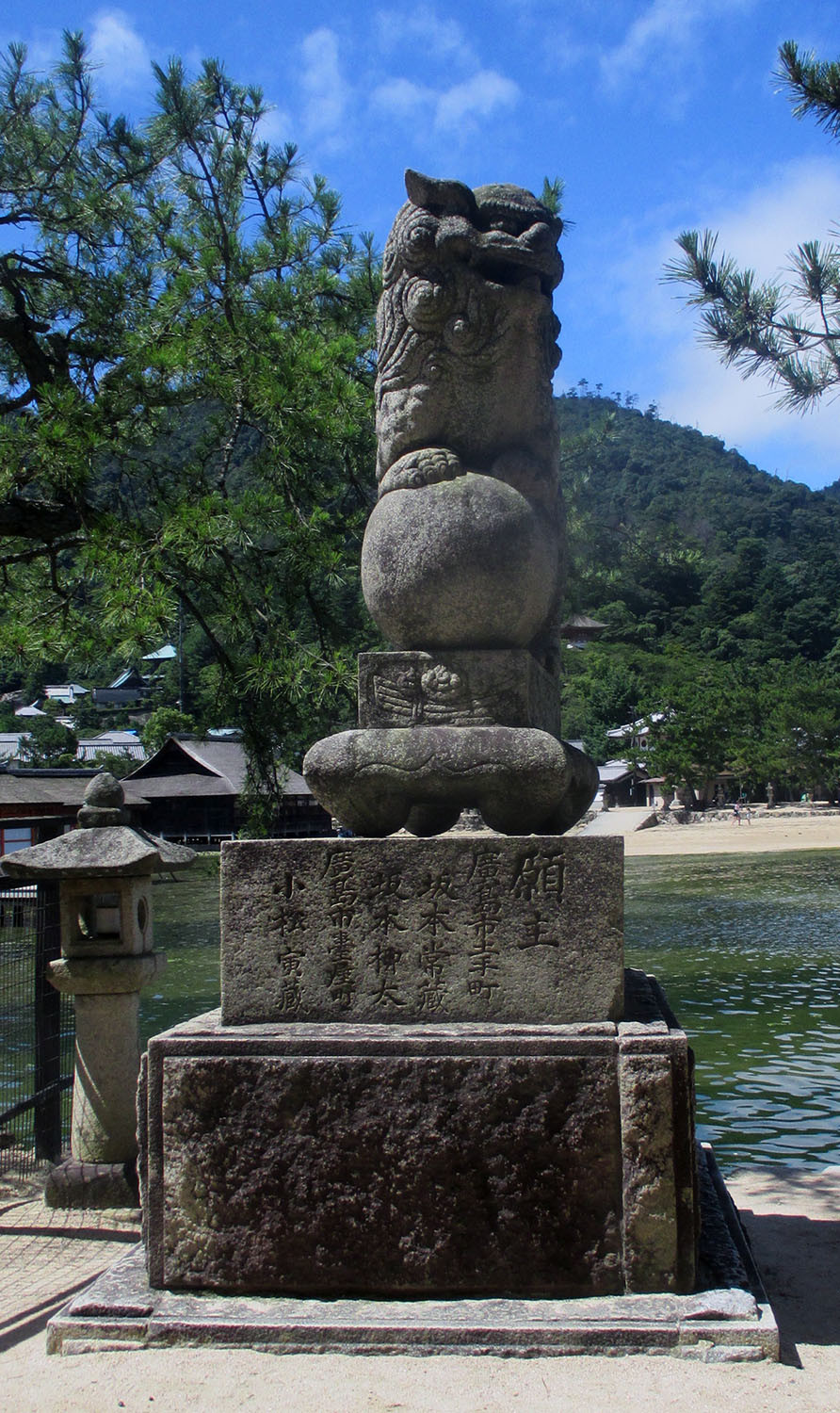
If some of you can read the Japanese here please share it below in the comments, I am really curious to know something more about it.
Mijayima (Itsukushima) shrine
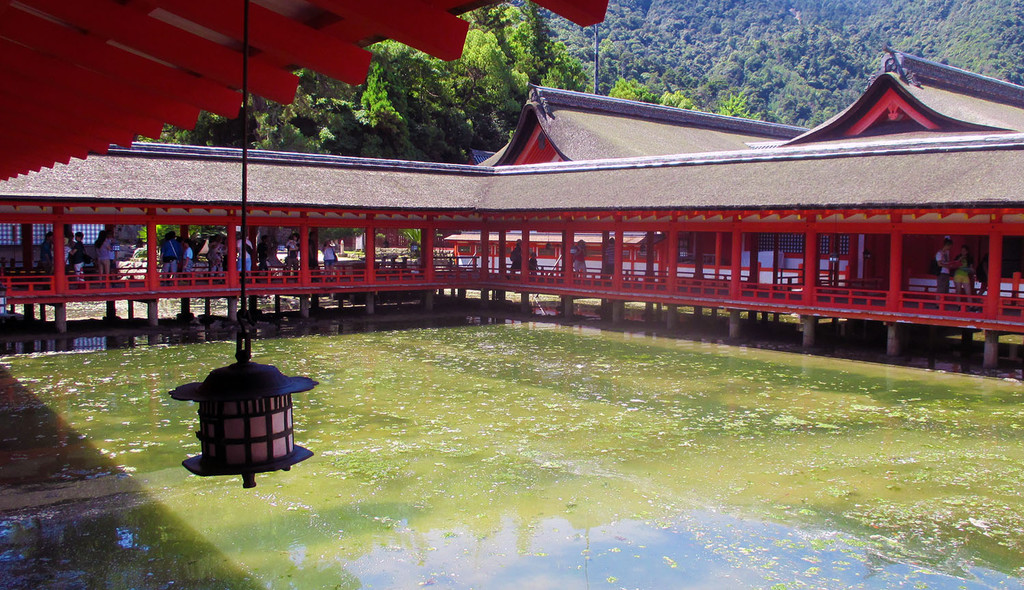
All the way down to the first platform of the shrine one can find lots of smaller columns along the promenade. And once we reached the entrance there were stairs as we had to go off the road for the platform.
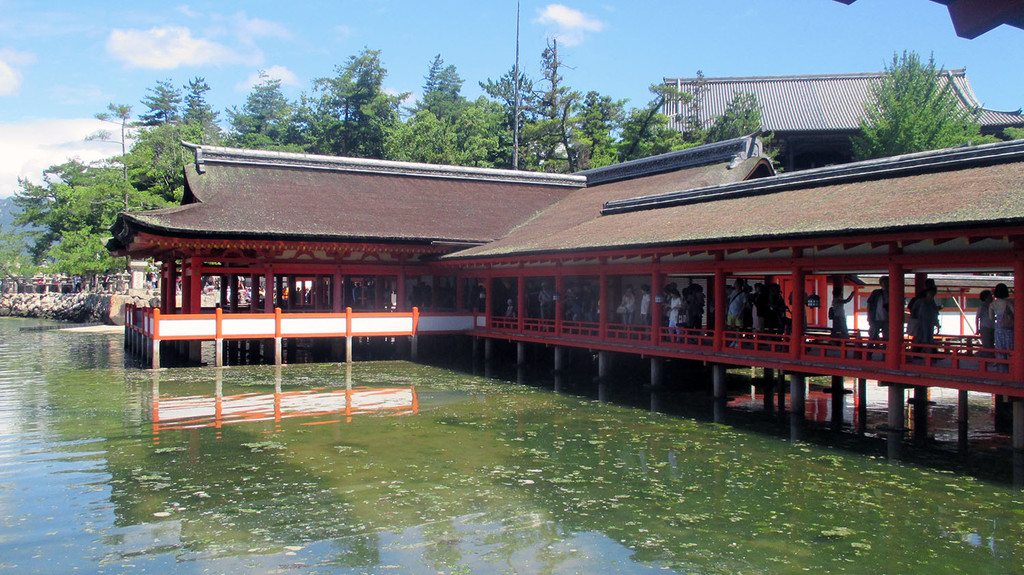
Before entering the shrine itself one has to go through the elementary steps. These include washing the hands with a large wooden spoon, first the left hand and then the right hand. Afterwards you are free to go. No one is of course obliged to do this but it would be nice to follow the local customs, ritual and the traditions.
The place was full of tourists and we were forced to move around slowly. Which is not that bad. I could split this again into 3 parts whereas in the biggest one - the biggest platform in the middle where we heard a music coming from. I looked over the other side and saw some guys dancing in the costumes. Apparently, that is a Noh stage.
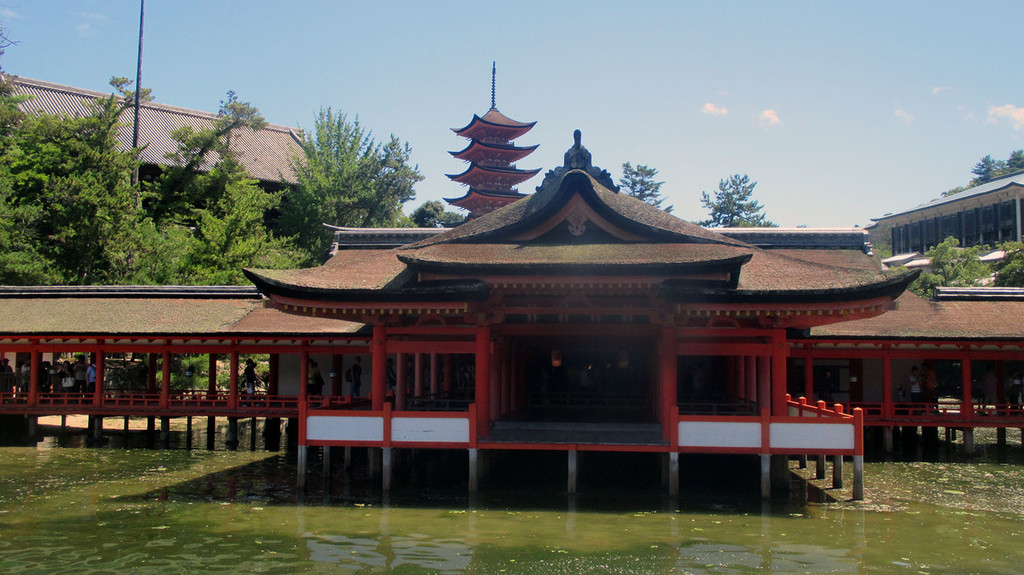
But wait to get there. There are several platforms connected with hallways (with roofs and protected from above as you can see) and at each one we would find some smaller shrine within with sculptures to some gods or... kind of souvenirs you could buy. I bought nothing.
Oh yeah, as you can see on the picture there is this feeling that we were on a lake not on the sea and you could see some fish swimming here and there between the hallways. The part here was very shallow and I believe the water would be much below my head had I been standing there.
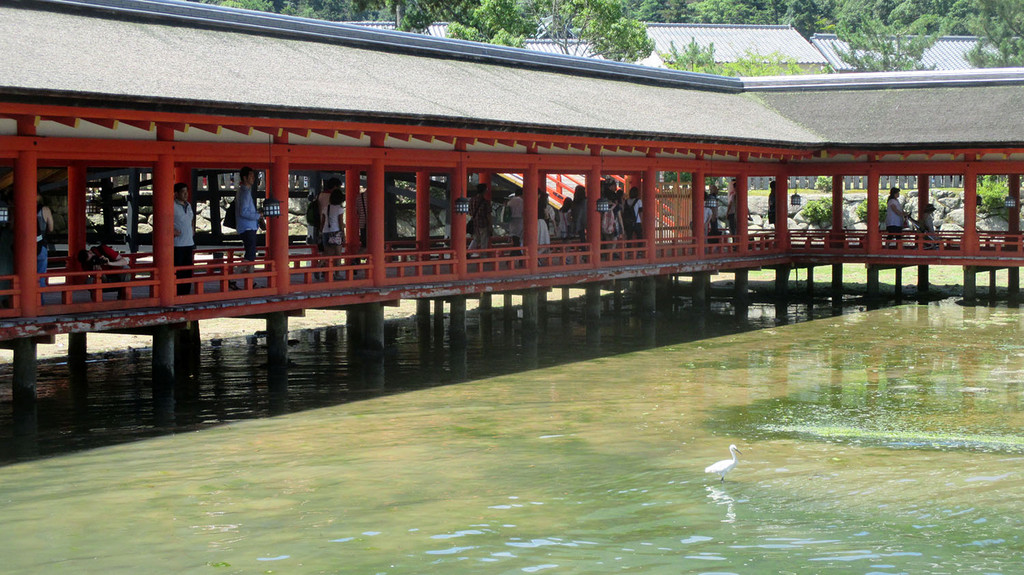
Soon we made a little circle around the hallways of platforms and came up to an open dock which was linked with the stage of the Noh play. I came here to the end of my film roll and and tried to replace it with the new film. And made a little mistake so half o my last shot (and it was a minute earlier) was destroyed. Well, I can use it as a postcard, as one of my friends commented.
Noh musical drama and dance on the stage
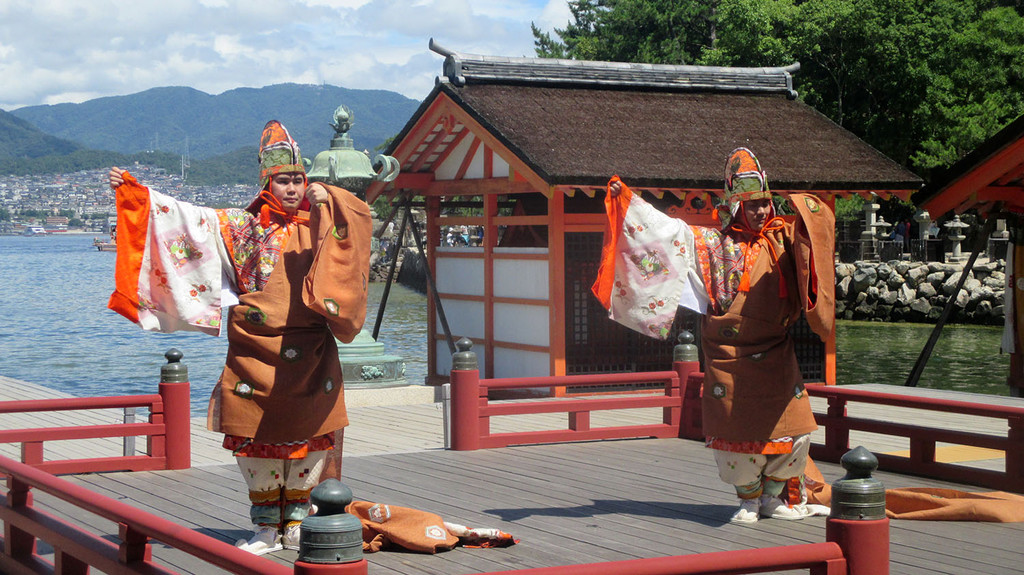
Finally in front of these guys. They were dancing with the music in the background and the music was... pretty interesting... kind of a bit strange... you will surely feel strange when you hear it. I stood there listening to it a bit more and then had to keep up with the others not to lose them out of sight. Each of the camp staff was in one of the smaller groups in order not to lose us.
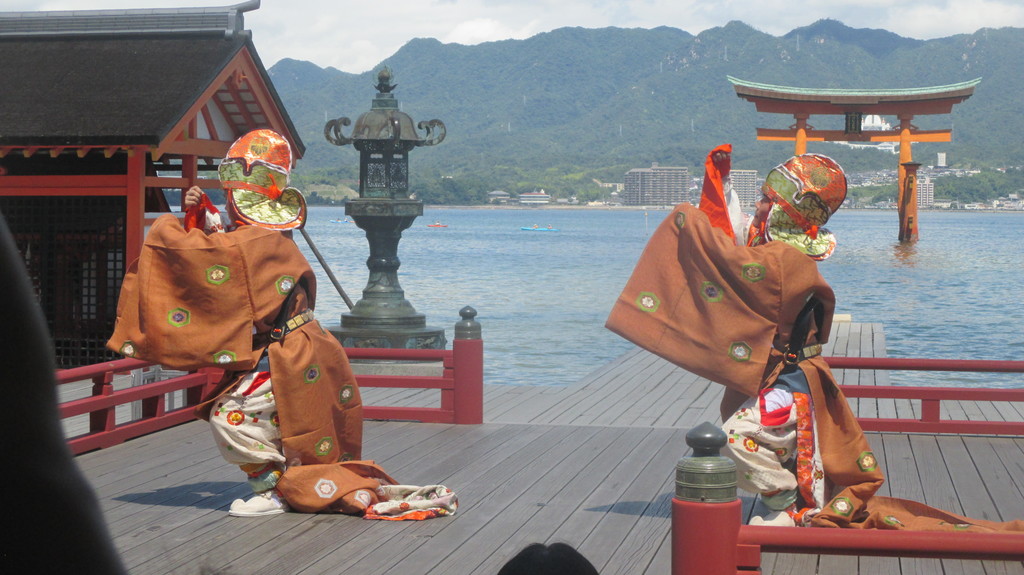
So, these two guys continued they strange dance. And the stage here in Miyajima is the oldest Noh stage in Japan! It dates back to the end of the 16th century. The dramas here are mostly based on some tales with superficial plot.
We were now about to leave the shrine and followed the long hallway which ended up with a bridge and... we are on the other side, on "land". And the next on our list was...
Lunch break with Hiroshima Okonomiyaki
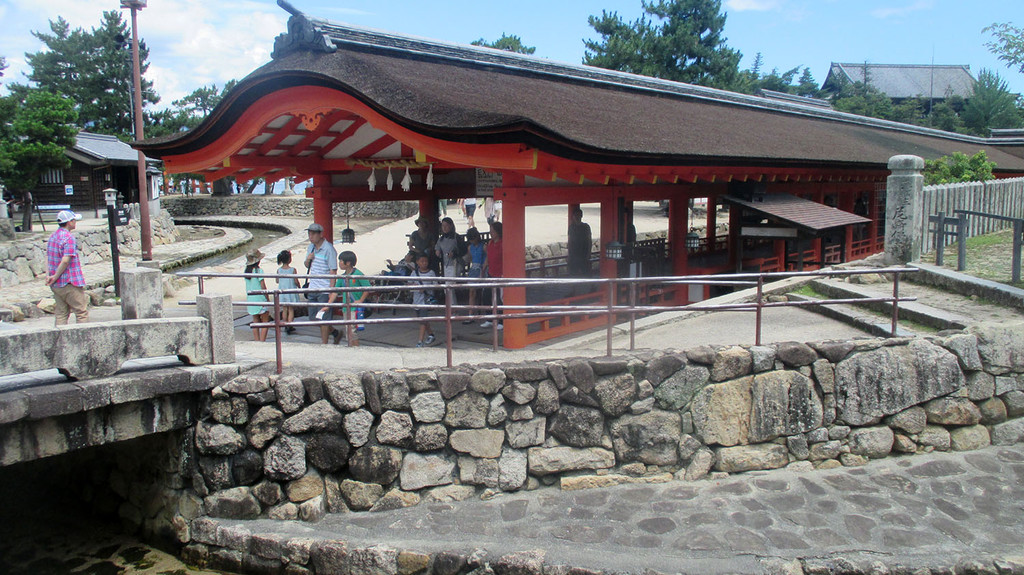
This is what the exit from the shrine looks like.
After crossing the bridge we found ourselves in front of Daiganji shrine... that's it. But we did not go further into that direction but rather turned around and were about to make a circle around the shrine to reach the other half (one we came from).
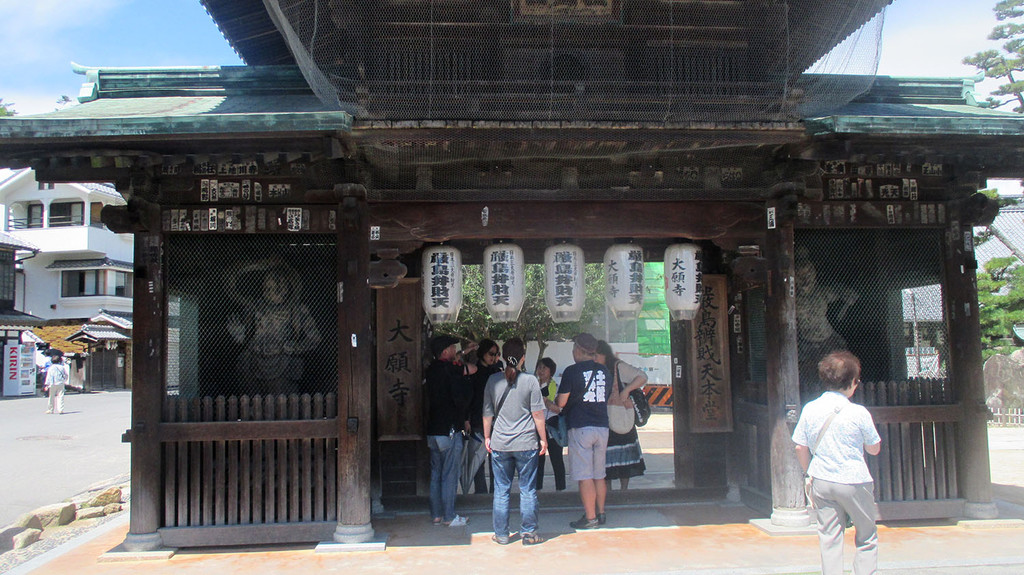
The plan was go to make a lunch break in the Omotesando Street. On our way there our souls were again tempted with numerous souvenirs shops. We had to wait until lunch time was over.
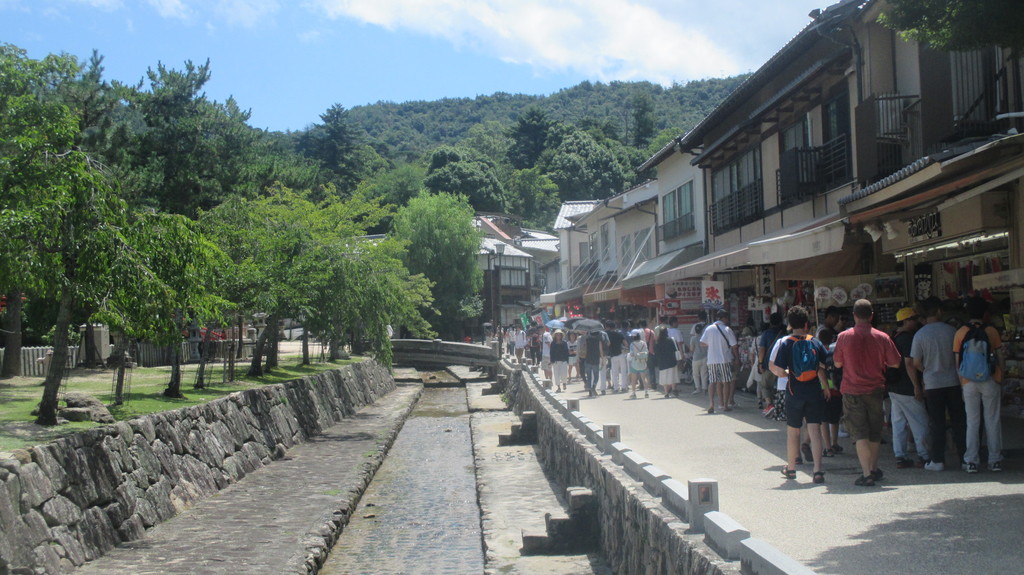
We got into the street which was full of people and tons of shops that were calling us. But they led us first to the restaurant where we had to the special kind of barbecue Hiroshima Okonomiyaki which looked pretty big and made you satisfied pretty quick. It could be described as a Japanese variant of thick American pancakes but with lots of meat and vegetables inside.
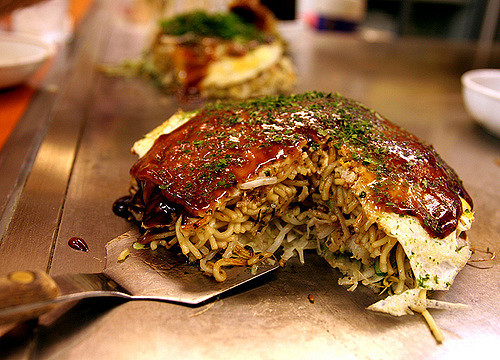
We spent there about 40 or more minutes sitting around 10 tables. My part was in the corner and we were planning what to do during the break. At the end of the lunch break we all thanked the cooks and hosts for their service and were given the further instructions.
Omotesando street and happy shopping
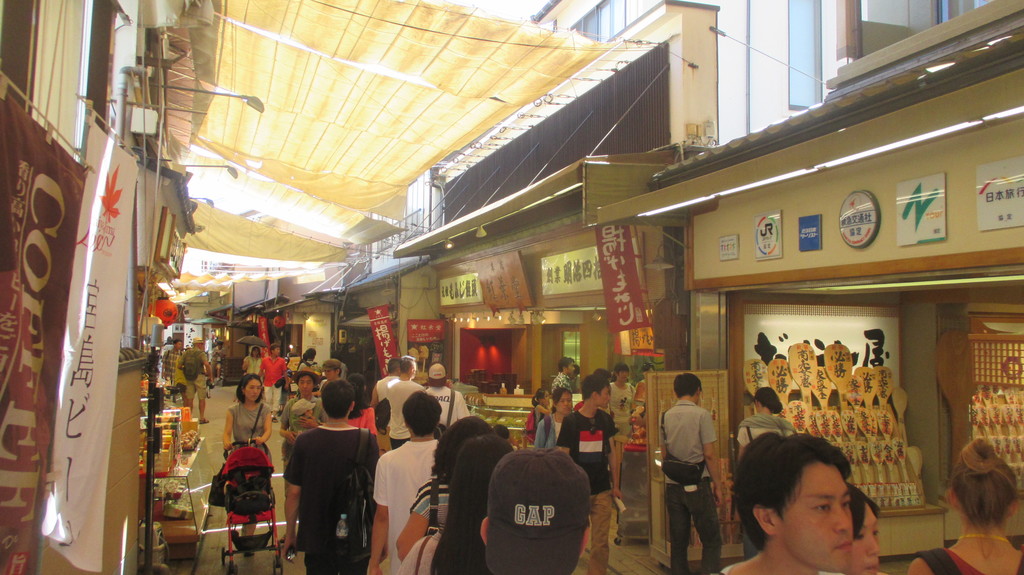
Finally! I was in the group of 3-4 of us and we decided to start going around the shops together and not get lost individually. There were numerous bakery, confection stores, ice-creams, souvenirs with t-shirts, toys, real swords, magnets...
We finally found on which had all of these. I bought there shirts for my family, some magnets, a cap for myself and... that was everything. I spent there pretty a lot (relatively) but was happy because hey - when am I going to visit the place again? My hands were full of the plastic bags and I was scared I would not have enough space on my way back home. The prices here were about 10-15 euros per shirt if I remember.

I saw there lots of swords and samurai stuff which was dragging us... but successfully resisted!
After about 20 minutes of being there we went out of the street, waited for some other friends and then got really tired of everything and tried to find a place to seat.
If you are then going into direction of the Miyajima shrine you will pass by one pretty open and big street that connects you back with the promenade. This is the street I mentioned earlier.
We saw there a table and some house on the wheels with strange guys jumping around.
Meeting the samurais and doing the Dragon Ball Z energy blast
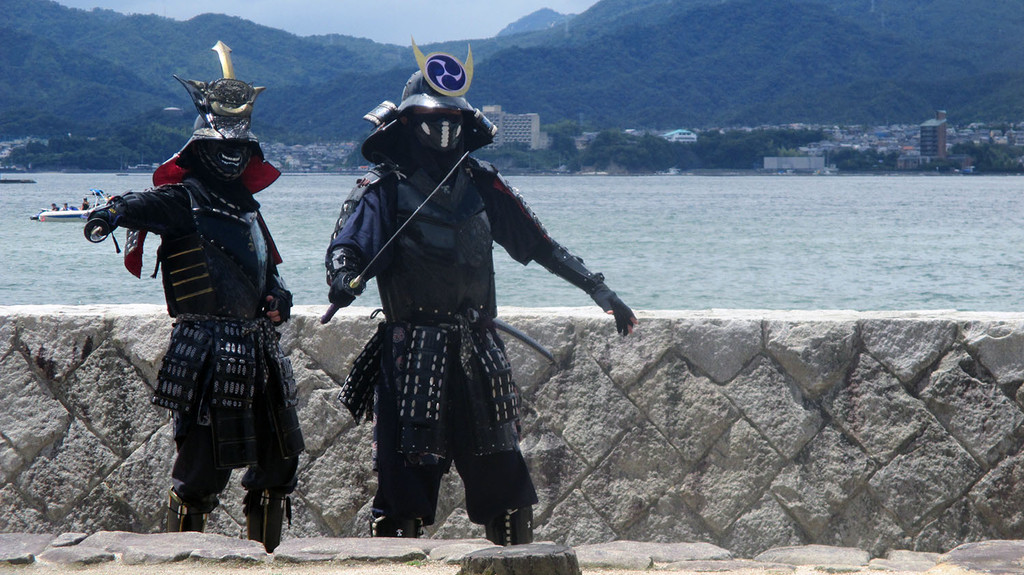
There were three samurais (two guys and one woman) ready to entertain the foreigners and maybe do some choreography if we paid them. We did not do that but I was lucky to take a photo of one of them and also took their helmet for a few seconds.
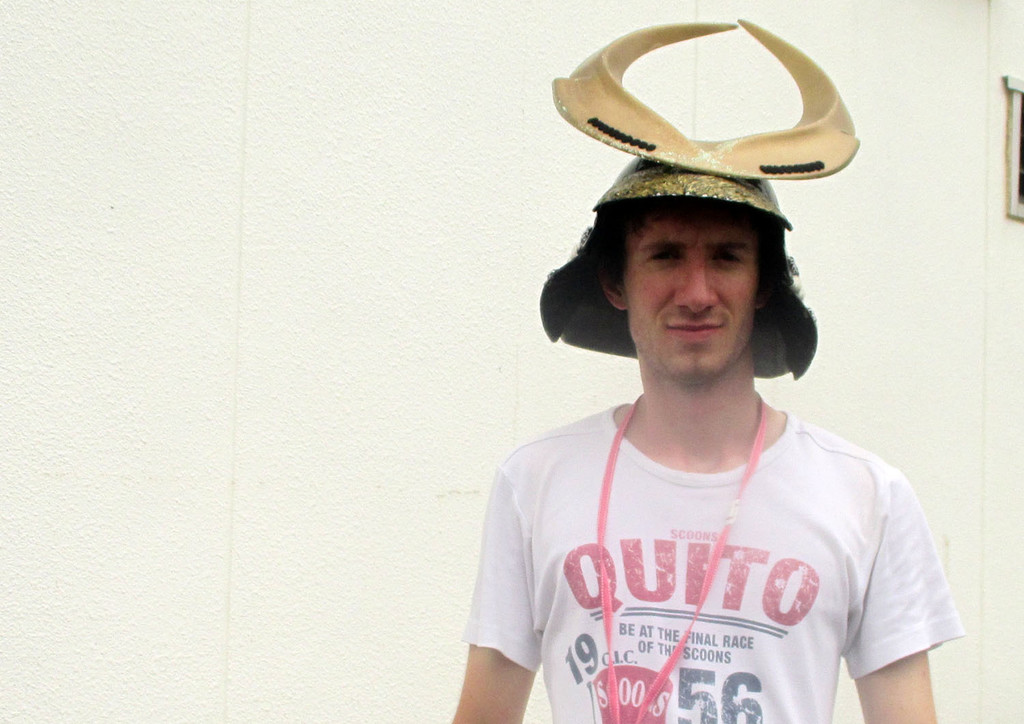
We found there one table and had nothing to order. Maybe it was not even part of some cafe so no one bothered us. Finally some minutes to sit down and rest.
And then I remembered one popular trend that I wanted to do in Japan and would not leave back to Croatia without doing it. The word is about the trend among the high school students who would simulate the scene from the Dragon Ball Z when one uses the energy (chi) to blast off the opponents. To do it properly one has to take a photograph of the scene at the moment everyone jumps in the air. I asked my colleagues (from Taiwan and Japan) whether they could help me and the last of the group (friend from Finland) take a photo of it. Now my mission was completed.
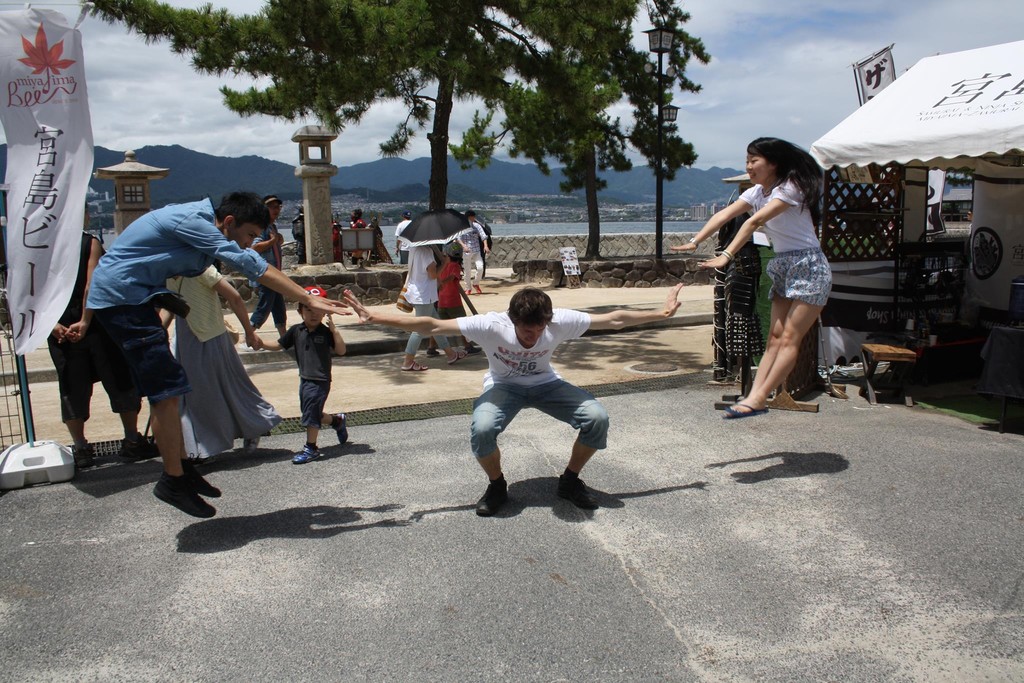
Great! Let's move on! After taking a photo in DBZ style we came closer to the samurais and I asked one for the picture. He or she came and I used my analog camera. Maybe too close though...next time will be better.
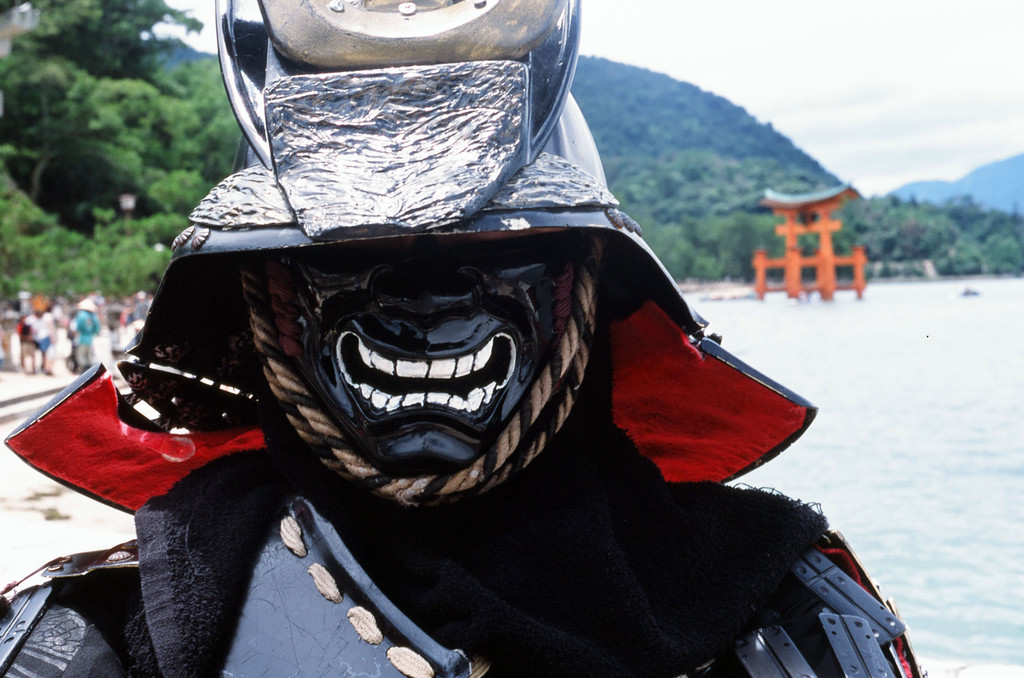
Leaving for the ferry terminal and arriving among the last
Time to go slowly to the ferry terminal as we had 15 more minutes before leaving the island. We took some drink from the vending machine on the street (and I took Pocari again, pretty predictable).
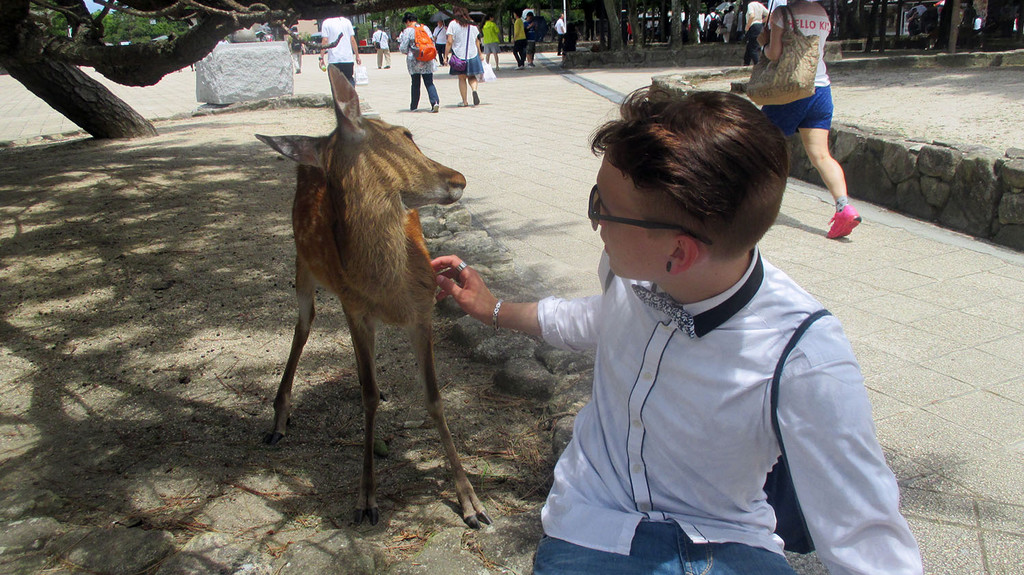
Once again there we waited a bit and sat in the shadows. Some of the deer came to us. After few minutes time to go to the Ferry terminal building as we saw the waiting line was forming.
After everyone was there and we made sure no one was going to be left on the island we boarded the ferry and continued our 10 minutes long journey to the other side.
Back on the "land“ Honshu about 13 h. and going for Osaka
Back in the bus for Osaka. I do not remember much of the trip to be honest except for talking with everyone and having lots of fun. I might have even slept a bit, after all it was about 5 hours to get there.
We stopped again several times at Lawson on the high way and got food in the bus. No one complained.
Arriving to Osaka in the evening
Yes, around the evening, maybe 17-18 h we arrived to Osaka. It was already sunset and the cool view from the hill when we were going down the road. We arrived to the hotel we spent two nights and then after shower time decided to postpone the country presentations for the next morning. Instead, we had organised...
Barbecue party (and plans for tomorrow)
Yes! In the huge yard of the hotel there was an area with wooden houses and alcoves with many tables and grills. The party lasted here for about 2 hours and many people join us. I think the whole LC that was with us that day joined the party but also several new campers. We enjoyed lots of good meat, vegetables, sweets and ice creams and had really a great time.
Before sleep we washed our clothes in the hotel's washing room and let them get dry outside on the balcony until the next day.
And the next day... well... time for some fun in the Universal Studios Japan!
Thanks for reading!
Photo gallery
Content available in other languages
Rate and comment about this place!
Do you know Miyajima Shrine (Itsukushima)? Share your opinion about this place.





















































